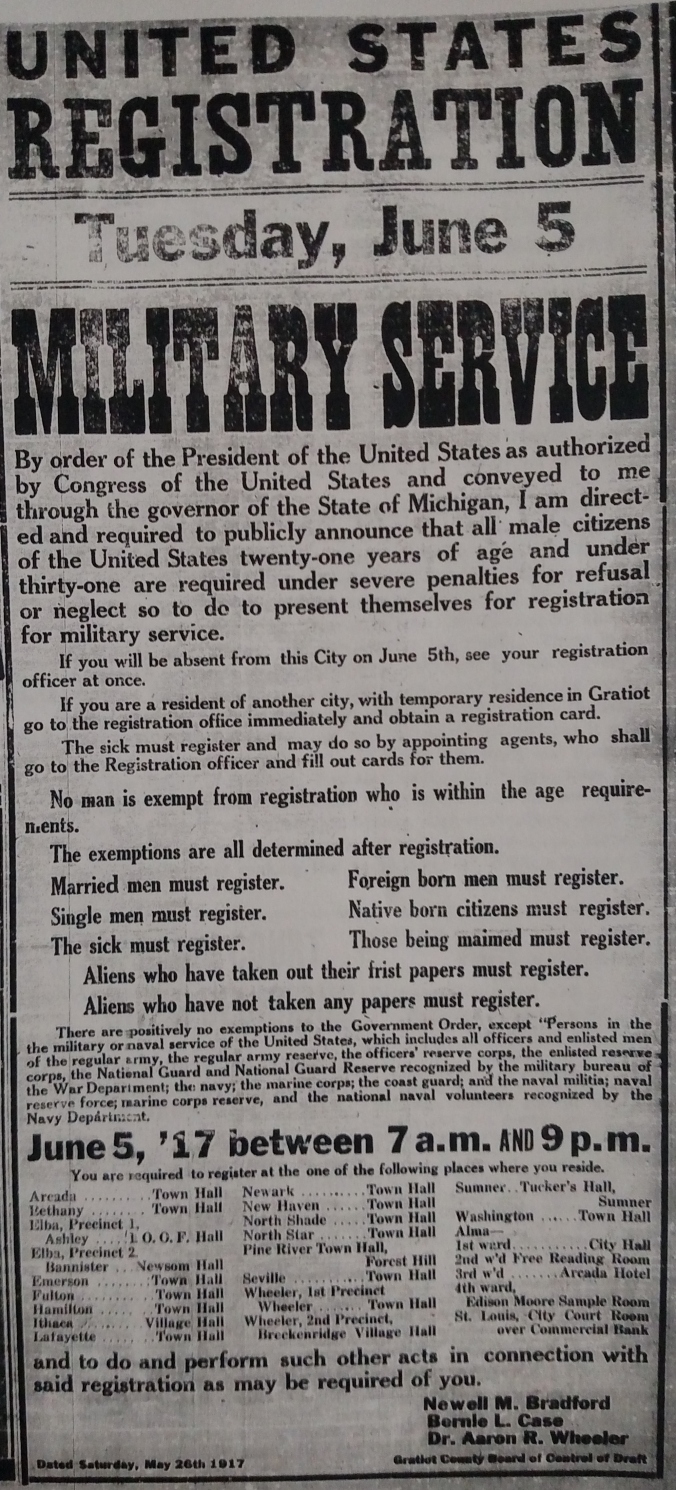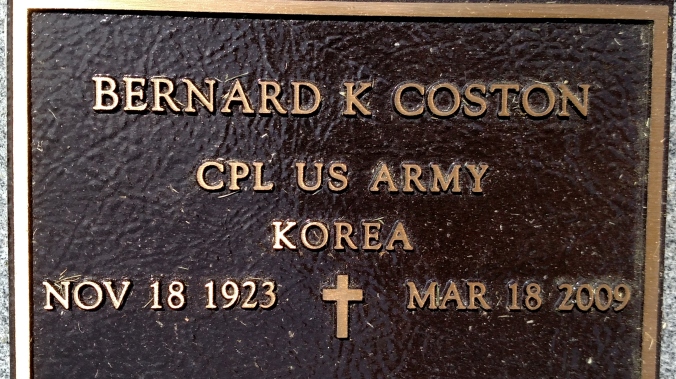 Only two months after a declaration of war, many people in Gratiot County in June 1917 had to be quickly reminded why they were involved in what was called “The Great War.” Local newspapers, like the Gratiot County Herald, reminded readers that “Every day reports come to us that even here in Gratiot county some intelligent people are inclined to poo poo the idea of any danger to America and ask ‘What are we in this for anyway?’” The answer? America (and Gratiot County) was in it to protect itself. Submarine warfare threatened America’s new allies and Germany was out to do one thing – to rule the world. If America did not win the war then everything the ancestors of Gratiot County residents did in 1776 and 1861 was in vain. All Americans were in this fight, they should get to it, get it over with and rid the world of Kaiserdom. Such was some of the news in Gratiot County in early June 1917.
Only two months after a declaration of war, many people in Gratiot County in June 1917 had to be quickly reminded why they were involved in what was called “The Great War.” Local newspapers, like the Gratiot County Herald, reminded readers that “Every day reports come to us that even here in Gratiot county some intelligent people are inclined to poo poo the idea of any danger to America and ask ‘What are we in this for anyway?’” The answer? America (and Gratiot County) was in it to protect itself. Submarine warfare threatened America’s new allies and Germany was out to do one thing – to rule the world. If America did not win the war then everything the ancestors of Gratiot County residents did in 1776 and 1861 was in vain. All Americans were in this fight, they should get to it, get it over with and rid the world of Kaiserdom. Such was some of the news in Gratiot County in early June 1917.
To further realize the urgency of this new war, reports came in from some of the earliest Gratiot County soldiers who witnessed the conflict. Arnold Robinson from Alma communicated that he had been aboard the S.S. Rochambeau and was headed for France when it was hit by a torpedo from an U-boat. The ship was hit in the propellers near the French coast, but it limped into port with 500 men on board. A St. Louis boy, S.D. Briggs, witnessed a battle between a merchant ship and a German sub just as the ship returned to the United States. This time the merchant ship actually hit the U-boat with two torpedoes, disabled and captured it. In reality, this new American involvement with the war at sea was just beginning.
The biggest news in June concerned the newly announced draft. Prior to this, volunteers from across the country – and Michigan – had rushed to get involved in the war. To this point Michigan easily met its volunteer quota of 5, 620 men and even exceeded it. However, the new task was to build a bigger armed forces and President Wilson instituted the first draft since the Civil War.
On June 5, 1917, all men between the ages of 21 and 30 had to register for the draft. Each had to appear at a designated place in their township to fill out an instruction card that had over ten questions on it. Usually these men appeared at a local township or village hall. In Ashley, they appeared at the I.O.O. F. Hall. In Alma, for part of the city men appeared at the Arcada Hotel. In St. Louis, it was the city court room above the Commerical Bank. Registrations across the county were peaceful. While Alma led the way with 673 men, men in places like Fulton (144), Newark Township (144), North Star (108) and Ashley (80) complied with the draft registration process.
Especially remarkable to one local newspaper was the observation of what was going on in Elba Township. Here, where one third to one half of all registrants were either foreign born or who were children of foreign born parents, descendants of Austrians, Hungarians and Bohemians were all enthusiastic about their desire to serve the country and their county. There seemed to be little question at this point about young Gratiot County men going off to war to fight countries that their families came from.
The next challenge came with forming a county draft board. The board would be made up of three men which included Sheriff Newell Bradford, County Clerk Bernie L. Case and Doctor Wheeler. Newell and Case were from Ithaca; Wheeler was from St. Louis. The job of the board was to take the registrant’s cards and then number each one consecutively in red ink. The cards were then sent to Washington, D.C. From there a national draft board instituted a lottery system to decide how many men had to be drafted from each county. A telegram then was sent to Gratiot County telling them what numbers had been chosen and how many men were to be drafted. Local county newspapers listed the numbers and the men.
Berry was not the last man to face such an accusation and “slacker raids” would take place later that summer in GratShortly afterward, names and stories began to appear of those Gratiot County men who did not want to register and who did not want to fight in the war. Michigan Governor Albert Sleeper sent telegrams to all counties to inform county sheriffs that they were under orders to pick up and detain all men in the 21 to 30 year age group who had not signed up for the draft. One man, Lloyd Berry, who came from Ogemaw Heights to work in the city of St. Louis, was one of the first to be accused of being a “slacker” – a name associated with those who were deemed unpatriotic, and seemingly cowardly. iot County.
Another big movement in Gratiot County that June included Liberty Bond drives. The Liberty Bond became the government’s way of financing a war and a way of getting all Americans involved in the war effort, even if they themselves could not serve in the army. As the Gratiot County Herald urged its readers, “Perhaps you can’t enlist. Buy a bond, and do your part.”
The first Liberty Bond meetings took place in fifteen locations across Gratiot County. The bonds sold for prices between $50 and $1000 and could be obtained at any local bank, like the Ithaca Savings Bank and the Commerical National Bank. The bonds paid 3 ½ % and they buying one was viewed as a patriotic duty.
Still another way that Gratiot County citizens could get involved with the war was to become a part of the newly formed Red Cross. The Red Cross initially tried to recruit 5,000 members from the county and it too presented itself as a patriotic duty. The lowest price for membership in the Red Cross was only one dollar. On June 24, 1917, every church in Gratiot County had its Sunday School celebrate what was called “Red Cross Day.” In Ithaca, one of the first formal organizational meetings took place in the Domestic Science Room at the local high school. Those who attended were urged to bring their thimbles and sewing needles. Ithaca soon became the county headquarters for the Gratiot County Red Cross program during the war. When local units were asked to help the county raise $7000 in its first drive the response was so enthusiastic that funds exceeded $10,000. Places like Breckenridge gave $650 – over three times its anticipated goal.
As June, 1917 came to an end, citizens of Gratiot County were presented with even more ways to support the war. Women were told that their household could not waste a single slice of wheat bread during the war. To make a point, the government instructed that if all the wasted bread in America was added up over one year then it could save over 356,000,000 loaves annually. Substitutes for preserving wheat bread were also presented. One of these was the use of corn or corn meal for wheat cakes, bread, biscuits, and rolls.
Participation and support for Gratiot County and its servicemen was just starting that summer of 1917.
Copyright 2017 James M Goodspeed
 Ralph J. Tinson, Sr. was born December 15, 1918 in Pontiac, Michigan to Stephen J. and Minnie Tinson. Ralph had 3 older siblings. Ralph married his wife Julia in 1942 and he entered the United States Army at Fort Sheridan, Illinois on June 12, 1944. Ralph was discharged on January 25, 1946. After the war he worked for the Gratiot County Road Commission for 31 years. He was a charter member and commander of the Ithaca VFW Post 7805. Ralph died on August 5, 1999 and he is buried in the Ithaca City Cemetery. Ralph J. Tinson is one of many Gratiot County men and women who served his county, state and nation during time of war.
Ralph J. Tinson, Sr. was born December 15, 1918 in Pontiac, Michigan to Stephen J. and Minnie Tinson. Ralph had 3 older siblings. Ralph married his wife Julia in 1942 and he entered the United States Army at Fort Sheridan, Illinois on June 12, 1944. Ralph was discharged on January 25, 1946. After the war he worked for the Gratiot County Road Commission for 31 years. He was a charter member and commander of the Ithaca VFW Post 7805. Ralph died on August 5, 1999 and he is buried in the Ithaca City Cemetery. Ralph J. Tinson is one of many Gratiot County men and women who served his county, state and nation during time of war.